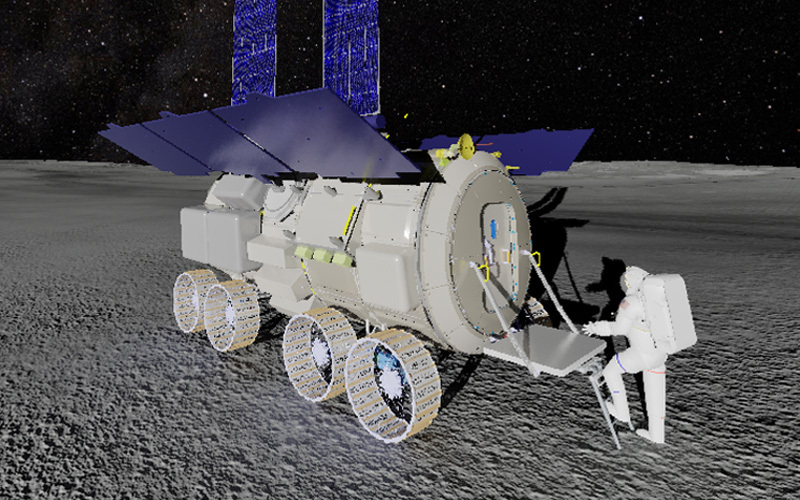10.12.2024

Credit: Thales Alenia Space
Thales Alenia Space Multi-Purpose Habitation module programme manager Nicola Genco has shared several key details about the planned first permanent human presence on the Moon.
In 2022, the Italian Space Agency (ASI) signed a pair of agreements with NASA that would see ASI take the lead on the preliminary design of the lunar surface Multi-Purpose Habitation (MPH) module. The MPH will offer astronauts the opportunity to visit the lunar surface as a means to extend scientific missions or, in emergency situations, act as a refuge.
In November 2023, Thales Alenia Space was awarded the contract to lead the module’s preliminary design process. In July 2024, both Thales and ASI announced that the preliminary design had passed a mission definition review. NASA will decide whether to move forward with the MPH module in late 2025.
While Thales and ASI have released few details about the design of the MPH module in official communications, an interview published by Fondazione Leonardo with the project’s program manager at Thales revealed several key details.
The MPH module will be six metres long with a diameter of three metres and a mass of around 15 tonnes. While initial iterations of the module envisioned it as a stationary outpost, its most recent design included the addition of wheels.
According to Genco, wheels were added to allow the module to move to the ideal location to survive the lunar night. The company is, however, also evaluating extending its range to enable it to use its new-found mobility to move to different locations to support various crewed Artemis missions to the lunar surface.
The module’s solar panels extend vertically several metres, a configuration that is necessary considering that the sun never rises above the lunar horizon more than one and a half degrees on the Moon’s South Pole, where it will be stationed.
In addition to the challenge of powering MPH, the harsh conditions of the surface of the Moon are also a key contributor to its design. Thales is exploring using coatings to deal with lunar dust, shielding to protect astronauts and equipment from radiation and extreme temperatures, and different approaches to ensuring the psychological well-being of its occupants.
With a limited inner volume, the space within MPH will be adaptable. For instance, the module will not feature a bedroom. Instead, astronauts will use mattresses on the floor when it’s time to catch some shut-eye. Genco described the interior design as featuring “modular solutions that can change shape based on use and time of day.” The company has, however, not yet paid “much attention to the exact shape of what the toilet will be like.”
The current design of the MPH module will be capable of supporting two astronauts for one mission per year, lasting seven to 30 days. The company is also exploring scenarios that will see the module host more astronauts for shorter periods of time. During the other 11 months, the module will be tasked with conducting scientific experiments autonomously.
As the module has not been assigned to a specific lunar lander, it is currently being designed to be launched aboard both the SpaceX and Blue Origin lunar landers being developed for the Artemis programme. If ASI and Thales get the green light to push forward with its development, the module will be available for launch early next decade.
+++
Italy’s Lunar Surface Habitat Passes Key Milestone

Credit: ASI/Thales Alenia Space
The Italian Space Agency announced 25 July that its lunar surface Multi-Purpose Habitation module has passed a mission definition review.
In late 2022, the Italian Space Agency (ASI) signed an agreement with NASA to cooperate in achieving the goals of the US agency’s Artemis programme. This cooperation was better defined in June 2022 with the signing of a bilateral cooperation agreement that would see ASI oversee the preliminary design of the lunar surface Multi-Purpose Habitation (MPH) module.
The MPH module is intended to offer astronauts visiting the surface of the Moon a lunar refuge and a means to extend scientific missions beyond the resource limits of what could be carried aboard a crewed lander.
In November 2023, ASI awarded Thales Alenia Space a contract to complete the MPH preliminary design. On 25 July, both ASI and Thales announced that this process had been completed. ASI conducted the MPH module’s mission definition review with participation from Thales Alenia Space representatives and under the supervision of NASA experts.
“The Mission Definition Review of the Multi-Purpose Habitation Module (MPH) is a key milestone that marks the evolution of the first permanent module, destined for human life on the Moon’s surface,” explained Thales Alenia Space in a statement.
A decision on whether or not to move forward with the development of the MPH module will be made by NASA in September 2025. If the agency gives the project the green light, it will be adopted into the agency’s Artemis programme as part of its Moon to Mars Strategy.
Quelle: European Spaceflight
